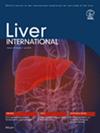We aimed to investigate whether gut microbiota could predict the treatment response to pharmacological agents among metabolic dysfunction-associated steatotic liver disease (MASLD) patients without diabetes mellitus (DM), as data are lacking.
We prospectively followed up non-diabetic MASLD patients who used empagliflozin. Clinical, anthropometric, laboratory assessments and magnetic resonance imaging-proton density fat fraction (MRI-PDFF) were performed from baseline to week 52 (EOT). Baseline stool samples were collected, and shotgun DNA metagenomic sequencing was performed to profile microbiome. The primary outcome was treatment response to empagliflozin at EOT, defined as MRI-PDFF decline ≥ 30% at EOT from baseline. Linear discriminant analysis [LDA] effect size was used to identify putative bacterial species. Multivariable logistic regression was used to derive adjusted odds ratio (aOR) of outcome with bacterial species by adjusting for clinical factors.
Twenty-two (48.9%) of 45 patients (median age: 56.9 years [IQR: 51.0–63.2]; male: 23 [51.1%]) achieved treatment response at EOT. There was difference in alpha diversity (Shannon index: p < 0.001; Simpson index: p = 0.001) and beta diversity (p = 0.048) in baseline microbiome between treatment response and non-response groups. Faecalibacterium prausnitzii (log10LDAscore = 4.27), Lachnospira pectinoschiza (log10LDAscore = 3.99), Anaerostipes hadrus (log10LDAscore = 3.98), Roseburia faecis (log10LDAscore = 3.97), Roseburia inulinivorans (log10LDAscore = 3.58) and Agathobaculum butyriciproducens (log10LDAscore = 2.77) were enriched in the treatment response group. L. pectinoschiza (aOR: 34.1; p = 0.015), A. hadrus (aOR:35.0; p = 0.032) and A. butyriciproducens (aOR:22.3; p = 0.023) independently predicted treatment response but not clinical factors. These three species collectively predicted treatment response with AUROC of 0.89 (95% CI: 0.80–0.99).
Certain gut bacterial species, particularly the combination of A. hadrus, L. pectinoschiza and A. butyriciproducens, may predict treatment response to empagliflozin in MAFLD patients without DM.



